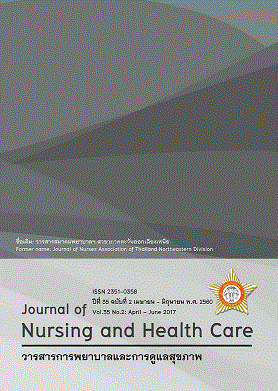การพัฒนารูปแบบการเฝ้าระวังและส่งเสริมเด็กปฐมวัยที่มีพัฒนาการล่าช้าในจังหวัดบุรีรัมย์ Development of Surveillance and Promotion Model for Early Childhood with Developmental Delay in Buriram Province
คำสำคัญ:
การพัฒนารูปแบบ, การเฝ้าระวัง, เด็กปฐมวัย, พัฒนาการล่าช้า model development, surveillance, delayed development, early childhoodบทคัดย่อ
บทคัดย่อ
การวิจัยเชิงปฏิบัติการนี้มีวัตถุประสงค์เพื่อพัฒนารูปแบบการเฝ้าระวังและส่งเสริมเด็กปฐมวัยที่มีพัฒนาการล่าช้าในจังหวัดบุรีรัมย์ เริ่มจาก ผู้มีส่วนเกี่ยวข้องวิเคราะห์หาสาเหตุ วางแผน หลังจากนั้นดำเนินโครงการ ติดตามประเมินผล และสรุปบทเรียน ผู้เข้าร่วมโครงการ ประกอบด้วย บุคลากรและผู้ที่เกี่ยวข้องกับพัฒนาการเด็กและสมัครใจเข้าร่วมวิจัย ทั้งบุคลากร ผู้ปกครอง และเด็กปฐมวัย เครื่องมือที่ใช้ได้แก่ แบบบันทึกเก็บรวบรวมสถานการณ์ แนวคำถามการจัดประชุมระดมสมองและการสัมภาษณ์ผู้ให้ข้อมูลสำคัญ แบบรายงานการเฝ้าระวังและส่งเสริมพัฒนาการเด็กปฐมวัย และกลุ่มเสี่ยง สรุปข้อมูลเชิงปริมาณโดยใช้การแจกแจงความถี่ และร้อยละ ข้อมูลเชิงคุณภาพด้วยการจัดหมวดหมู่ และสรุปประเด็นสำคัญ
จากการวิเคราะห์สถานการณ์พบว่า การเชื่อมโยงระหว่างหน่วยงานที่เกี่ยวข้องยังมีน้อย บุคลากรที่มีส่วนเกี่ยวข้องมีความรู้ และทักษะการตรวจพัฒนาการไม่เพียงพอ การที่เด็กอาศัยอยู่กับผู้สูงอายุเนื่องจากผู้ปกครองต้องไปทำงานนอกพื้นที่ การเชื่อมโยงข้อมูลระหว่างหน่วยบริการไม่ครบถ้วน รวมทั้งบุคลากรทางการแพทย์และพยาบาลเฉพาะทางมีน้อย ส่งผลให้การเข้าถึงและตรวจ กระตุ้นพัฒนาการเด็กล่าช้าไม่ครอบคลุม
การดำเนินการพัฒนารูปแบบเริ่มจากทำคำสั่งแต่งตั้ง ตลอดจนทำความเข้าใจกับผู้เกี่ยวข้องจากทุกภาคส่วนให้เข้าใจบทบาท มีการพัฒนาบุคลากรให้มีความรู้และทักษะในการใช้เครื่องมือตรวจพัฒนาการ ประสานกับทีมพื้นที่เพื่อประเมินและส่งเสริมพัฒนาการเด็ก มีการจัดทำทะเบียนรายชื่อเด็กกลุ่มเสี่ยง และส่งข้อมูลให้พื้นที่เพื่อติดตามคัดกรองพัฒนาการเด็ก การจัดประชุมและตรวจคัดกรองเด็กที่สงสัยพัฒนาการล่าช้าตามโซนจังหวัด 4 โซน ขยายวันให้บริการคลินิกสุขภาพเด็กดี รวมทั้งการสนับสนุนงบประมาณ วัสดุ อุปกรณ์ มีการรายงานผลทุก 3 เดือน เพื่อติดตามผลการดำเนินงาน
ผลลัพธ์หลังจากการพัฒนารูปแบบ พบว่า ความครอบคลุมของการตรวจพัฒนาการและเข้าถึงบริการของเด็กที่มีพัฒนาการล่าช้าเพิ่มขึ้น ทำให้เด็กได้รับการกระตุ้น และส่งเสริม จนเด็กมีพัฒนาการปกติ ผู้มีส่วนเกี่ยวข้องมีความเข้าใจในการเฝ้าระวังพัฒนาการเด็ก มีระบบทะเบียนให้เจ้าหน้าที่ในพื้นที่ได้ติดตาม ช่วยในการเฝ้าระวังเด็กที่มีพัฒนาการล่าช้า ทำให้ได้รูปแบบการเฝ้าระวังและส่งเสริมเด็กปฐมวัยที่มีพัฒนาการล่าช้าที่เหมาะสม
Abstract
This action research aimed to develop model for surveillance and promoting early childhood with developmental delays in Buriram province. Stakeholder were situation analyses, planed, implement, evaluation and conclusion lessons learned. Volunteers participants included provincial Maternal and Child Health board members, districts committee, child development personnel, Family Care Team, Child Development Centers’ personnel, health volunteers, and young children with parents/caregivers. Study instruments included situation record form, brainstorming guideline, key informant interviews guideline, and report on surveillance and promotion of early childhood development. Quantitative data were analyzed using frequency and percentage. Classification and summary were used to summarize qualitative data.
It was found that coordination among agencies and stakeholders was insufficient; respective personnel did not have enough developmental knowledge and assessment skills; a few children live with the elderly because their parents had to work outside the area; the connection among service units was incomplete; and medical personnel and specialized nurses were few. This situation resulted in access issues of assessing and promoting child development.
This model development started with stakeholders and working group appointment followed by committee meeting to identify roles and responsibilities. Training were used to develop knowledge and skills for developmental assessment. Local teams were coordinated to assess and promote child development. Record of children at risk was made and shared with local area team to monitor child development. Children with suspected developmental delays were reported to the provincial health zones to schedule screening appointment. Child development clinic was extent. The developed model received budget and resource support and was monitored for performance every three months.
After model implementation, there was an increase in the coverage of developmental screening and access to delayed developmental services resulting in child developmental improvement. The stakeholders understand needs of child development monitoring and developed monitoring system for local authorities. This developed model of surveillance and promotion of early childhood with developmental delays can improve child development.



